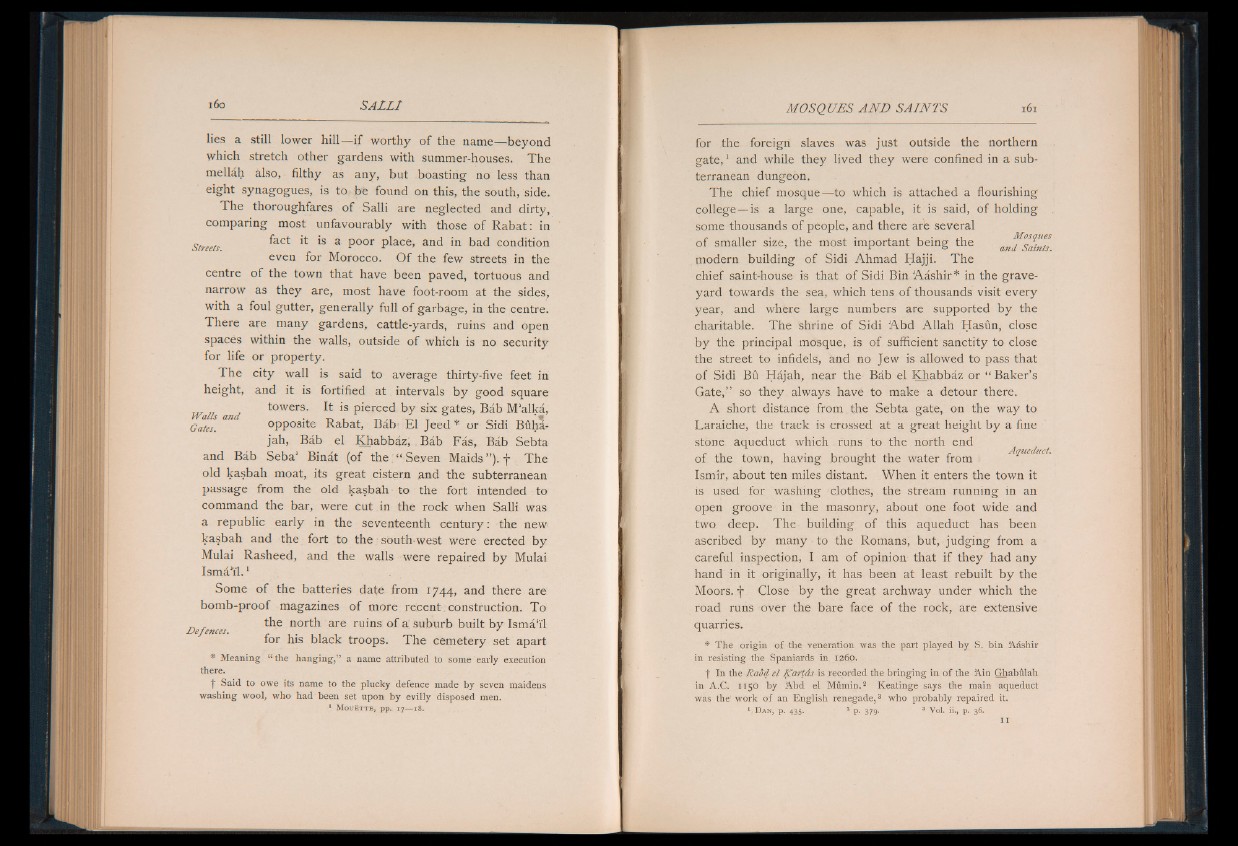
lies a still lower hill— if worthy of the name— beyond
which stretch other gardens with summer-houses. The
mellah also, filthy as any, but boasting no less than
eight synagogues, is to be found on this, the south, side.
The thoroughfares of Salli are neglected and dirty,
comparing most unfavourably with those of Rabat: in
Streets ^a c t it is a poor place, and in bad condition
even for Morocco. Of the few streets in the
centre of the town that have been paved, tortuous and
narrow as they are, most have foot-room at the sides,
with a foul gutter, generally full of garbage, in the centre.
There are many gardens, cattle-yards, ruins and open
spaces within the walls, outside of which is no security
for life or property.
The city wall is said to average thirty-five feet in
height, and it is fortified at intervals by good square
towers. It is pierced by six gates, Bab M'alka,
Walls and -r» i „ , **
Gates. opposite Rabat, Bab' El Jeed * or Sidi Buhajah,
Bab el Khabbaz; Bab Fas, Bab Sebta
and Bab Seba‘ Binat (of the “ Seven Maids ” ). f The
old kasbah moat, its great cistern and the subterranean
passage from the old kasbah to the fort intended to
command the bar, were cut in the rock when Salli was
a republic early in the seventeenth century: the new
kasbah and the fort to th e, south-west were erected by
Mulai Rasheed, and the walls were repaired by Mulai
Isma'il.1
Some of the batteries date from 1744, and there are
bomb-proof magazines of more recent construction. To
the north are ruins of a suburb built by Isma'il Defences. , J
for his black troops. The cemetery set apart
* Meaning “ the hanging,” a name attributed to some early execution
there.
f Said to owe its name to the plucky defence made by seven maidens
washing wool, who had been set upon by evilly disposed men.
1 M o u e t t e , p p . 1 7 — 18 .
for the foreign slaves was just outside the northern
gate,1 and while they lived they were confined in a subterranean
dungeon.
The chief mosque— to which is attached a flourishing
college —is a large one, capable, it is said, of holding
some thousands of people, and there are several
of smaller size, the most important being the \ °Saints
modern building of Sidi Ahmad Hajji. The
chief saint-house is that of Sidi Bin Aashir* in the graveyard
towards the sea, which tens of thousands visit every
year, and where large numbers are supported by the
charitable. The shrine of Sidi 'Abd Allah Hasun, close
by the principal mosque, is of sufficient sanctity to close
the street to infidels, and no Jew is allowed to pass that
of Sidi Bu Hajah, near the Bab el Khabbaz or “ Baker’s
Gate,” so they always have to make a detour there.
A short distance from the Sebta gate, on the way to
Laraiche, the track is crossed at a great height by a fine
stone aqueduct which runs to the north end
of the town, having brought the water from
Ismir, about ten miles distant. When it enters the town it
is used for washing clothes, the stream running in an
open groove in the masonry, about one foot wide and
two deep. The- building of this aqueduct has been
ascribed by many to the Romans, but, judging from a
careful inspection, I am of opinion that if they had any
hand in it originally, it has been at least rebuilt by the
Moors, f Close by the great archway under which the
road runs over the bare face of the rock, are extensive
quarries.
* The origin of the veneration was the part played by S. bin Aashir
in resisting the Spaniards in 1260.
f In the Radd el ICaftds is recorded the bringing in of the Ain Ghabulah
in A.C. 1150 by Abd el Mumin.2 Keatinge says the main aqueduct
was t h e 1 work of an English, renegade,3 who probably repaired it.
1 D a n , p . 435. 2 p . 379. 3 V o l. ii., p. 36.